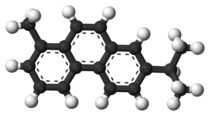This is an old revision of this page, as edited by Rjwilmsi (talk | contribs) at 21:19, 18 June 2011 (doi:10.1016/S0045-6535(98)00041-1). The present address (URL) is a permanent link to this revision, which may differ significantly from the current revision.
Revision as of 21:19, 18 June 2011 by Rjwilmsi (talk | contribs) (doi:10.1016/S0045-6535(98)00041-1)(diff) ← Previous revision | Latest revision (diff) | Newer revision → (diff)
| |

| |
| Names | |
|---|---|
| IUPAC name 7-Isopropyl-1-methylphenanthrene | |
| Other names Retene | |
| Identifiers | |
| CAS Number | |
| 3D model (JSmol) | |
| ECHA InfoCard | 100.006.908 |
| PubChem CID | |
| CompTox Dashboard (EPA) | |
SMILES
| |
| Properties | |
| Chemical formula | C18H18 |
| Molar mass | 234.33552 |
| Melting point | 98.5 °C |
| Boiling point | 390 °C |
| Except where otherwise noted, data are given for materials in their standard state (at 25 °C , 100 kPa).
| |
Retene, methyl isopropyl phenanthrene or 1-methyl-7-isopropyl phenanthrene, C18H18, is a polycyclic aromatic hydrocarbon present in the coal tar fraction, boiling above 360 °C. It occurs naturally in the tars obtained by the distillation of resinous woods. It crystallizes in large plates, which melt at 98.5 °C and boil at 390 °C. It is readily soluble in warm ether and in hot glacial acetic acid. Sodium and boiling amyl alcohol reduce it to a tetrahydroretene, whilst if it be heated with phosphorus and hydriodic acid to 260 °C, a dodecahydride is formed. Chromic acid oxidizes it to retene quinone, phthalic acid and acetic acid. It forms a picrate which melts at 123-124 °C.
Retene is derived by degradation of specific diterpenoids biologically produced by conifer trees.
The presence of traces of retene in the air is an indicator of forest fires; it is a major product of pyrolysis of conifer trees. It is also present in effluents from wood pulp and paper mills.
Retene, together with cadalene, simonellite and ip-iHMN, is a biomarker of higher plants, which makes it useful for paleobotanic analysis of rock sediments. Ratio of retene/cadalene in sediments can reveal the ratio of the genus Pinaceae in the biosphere.
References
- Unsolved Mysteries of Human Health, Community Outreach and Education Program, Oregon State University
- J. Koistinen, M. Lehtonena, K. Tukia, M. Soimasuo, M. Lahtiperab and A. Oikari (1998). "IDENTIFICATION OF LIPOPHILIC POLLUTANTS DISCHARGED FROM A FINNISH PULP AND PAPER MILL". Chemosphere. 37: 219–235. doi:10.1016/S0045-6535(98)00041-1. PMID 9650265.
{{cite journal}}: CS1 maint: multiple names: authors list (link) - Y. Hautevelle, R. Michels, F. Malartre and A. Trouiller (2005). "Vascular plant biomarkers as ancient vegetation proxies and their stratigraphic use for tracing paleoclimatic changes during Jurassic in Western Europe" (abstract). Geophysical Research Abstracts. 7: 10201.
{{cite journal}}: CS1 maint: multiple names: authors list (link)
![]() This article incorporates text from a publication now in the public domain: Chisholm, Hugh, ed. (1911). Encyclopædia Britannica (11th ed.). Cambridge University Press.
This article incorporates text from a publication now in the public domain: Chisholm, Hugh, ed. (1911). Encyclopædia Britannica (11th ed.). Cambridge University Press. {{cite encyclopedia}}: Missing or empty |title= (help)